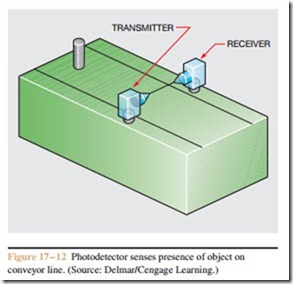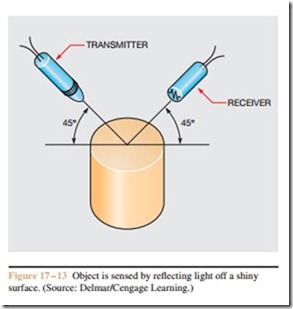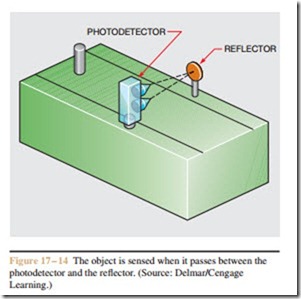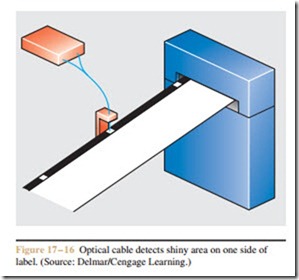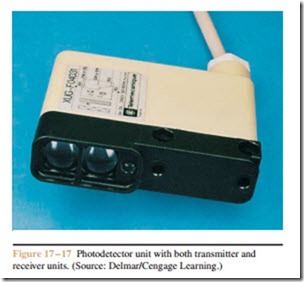Mounting
Photodetectors designed for industrial use are made to be mounted and used in different ways. There are two basic types of photodetectors: one type has separate transmitter and receiver units; the other type has both units mounted in the same housing. The type used is generally determined by the job requirements. The transmitter section is the light source, which is generally a long life incandescent bulb. There are photodetectors, however, that use an infrared transmitter. These cannot be seen by the human eye and are often used in burglar alarm systems. The receiver unit houses the photodetector and, generally, the circuitry required to operate the system.
Figure 17–12 shows a photodetector used to detect the presence of an object on the conveyor line.
When the object passes between the transmitter and receiver units, the light beam is broken and the detector activates. Notice that no physical contact is necessary
for the photodetector to sense the presence of the object.
Figure 17 – 13 illustrates another method of mount- ing the transmitter and receiver. In this example, an object is sensed by reflecting light off of a shiny sur- face. Notice that the transmitter and receiver must be mounted at the same angle with respect to the object to be sensed. This type of mounting will only work with objects that have the same height, such as cans on a conveyor line.
Photodetectors that have both the transmitter and the receiver units mounted in the same housing depend on a reflector for operation. Figure 17 – 14 shows this type of unit mounted on a conveyor line. The transmit- ter is aimed at the reflector. The light beam is reflected back to the receiver. When an object passes between the ceiver is interrupted. This type of unit has the advan- tage of needing electrical connection at only one piece of equipment. This permits easy mounting of the photo- detector unit and mounting of the reflector in hard to reach positions that would make running control wiring difficult. Many of these units have a range of 20 feet and more.
Another type of unit that operates on the principle of reflected light uses an optical fiber cable. The fibers in the cable are divided in half. One half of the fibers are connected to the transmitter, and the other half are con- nected to the receiver (Figure 17 – 15). This unit has the
advantage of permitting the transmitter and the receiver to be mounted in a very small area. Figure 17 – 16 illus- trates a common use for this type of unit. The unit is used to control a label-cutting machine. The labels are printed on a large roll and must be cut for individ- ual packages. The label roll contains a narrow strip on one side that is dark colored except for shiny sec- tions spaced at regular intervals. The optical fiber cable is located above this narrow strip. When the dark
surface of the strip is passing beneath the optical cable, no reflected light returns to the receiver unit. When the shiny section passes beneath the cable, light is reflected back to the receiver unit. The photodetector sends a signal to the control circuit and tells it to cut the label.
Photodetectors are very dependable and have an excellent maintenance and service record. They can be used to sense almost any object without making physical contact with it, and can operate millions of times without damage or wear. A photodetector is shown in Figure 17 – 17.
Review Questions
1. List the three major categories of photodetectors.
2. In which category does the solar cell belong?
3. In which category do phototransistors and photodiodes belong?
4. In which category does the cad cell belong?
5. The term cad cell is a common name for what device?
6. What is the function of the transmitter in a photodetector unit?
7. What is the advantage of a photodetector that uses a reflector to operate?
8. An object is to be detected by reflecting light off a shiny surface. If the transmitter is mounted at a 60 degree angle, at what angle must the receiver be mounted?
9. How much voltage is produced by a silicon solar cell?
10. What determines the amount of current a solar cell can produce?
